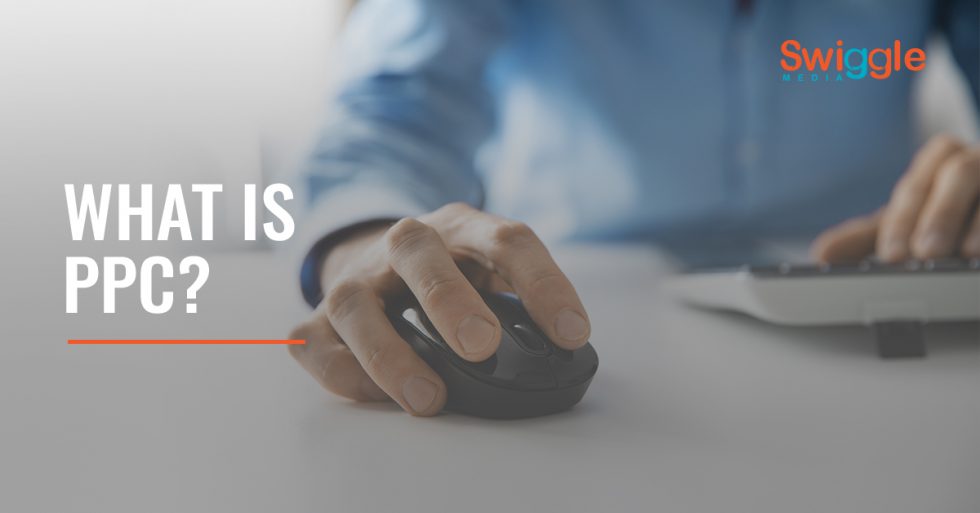Before you start reading, I want you to know what this is all about. I want to do two things for you:
- Provide you with the tools necessary to start doing SEO for your business
- Share with you the knowledge required to properly outsource your SEO marketing.
That’s why I wrote this blog post. I find it important for specific industries and niches to learn about how SEO works for their respective companies and how my company changes strategies to make your business succeed. I’m not gonna lie, I want your business. The best way to show you that I’m worthy of your business is to explain what I can do to rank your company’s website. This blog will show you exactly what I know about SEO and how it pertains to your plumbing company. Fair warning, this is a 5,500 word guide.
Navigation
After reading this step-by-step guide, you’ll have an understanding of how you can implement SEO into your company’s website. It’s also a very condensed version of what Swiggle Media would do for your company if you hired us. You may be thinking, 5,500 words is condensed? Yes, it is! SEO is extremely complicated and always evolving. It would take 50,000 to truly explain all that goes into SEO implementation. And that’s just the tip of the iceberg. Use the link navigation below to skip around:
- How to find keywords
- How to beat your competitors
- How to improve your site structure
- How to appear in local searches
- How to create good content
- How to link build
- How to track your ROI
How to Find Keywords
Finding keywords is a crucial step that happens way before any SEO implementation. It’s the planning phase and it’s where we find the triggers that activate your website’s potential. Research is the first step in finding keywords that will help you determine the level of traffic to your site, where your site pages rank, and whether visitors convert into leads.
The Process
Let me lay out the process I go through to find the most effective keywords. We’ll use Orlando Roofing Company as my keyword search. There’s a way I typically do things that have worked for other companies that I’ve done SEO for and I’m going to share that with you. To start off, I list out a few keywords that have to do with the business I’m marketing for. I typically start off with local searches so you’ll see Orlando here. Fun fact: Swiggle Media is based in Orlando but we perform marketing services for companies from all over the nation!
- Orlando plumbing company
- Plumbers in Orlando
- Orlando Plumbing Repair
- Plumbing Repair in Orlando
You probably notice that these keywords look mostly the same, with the order mixed up. Order matters, trust me. I use Keyword Planner from Google to figure out the search volume for the keywords I formulate. The cool thing is that it even suggests other keywords you could rank for. Click the link to check it out. If you don’t have an account, I suggest signing up. If you want to just follow along, that’s cool too. First things first, we need to test our chosen keywords. Click the box on the left after signing in and type in your keywords. Click get results when you’re done.
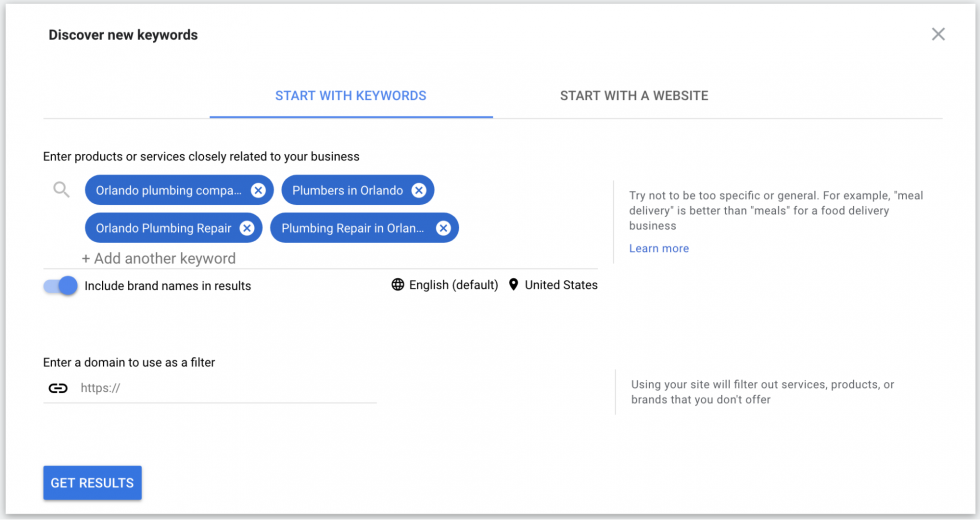
you get the results, the below image is what you see. It gives you volume trends, how competitive a keyword is, how much you should bid on a word if you start a PPC (pay per click) campaign, and the average monthly search volume. According to the chart, Orlando Plumber had the most average monthly searches so we’ll be using that as our main keyword. Now that we have all this data, click download keyword ideas at the top right of the screen so we can have a list of suggested keywords.
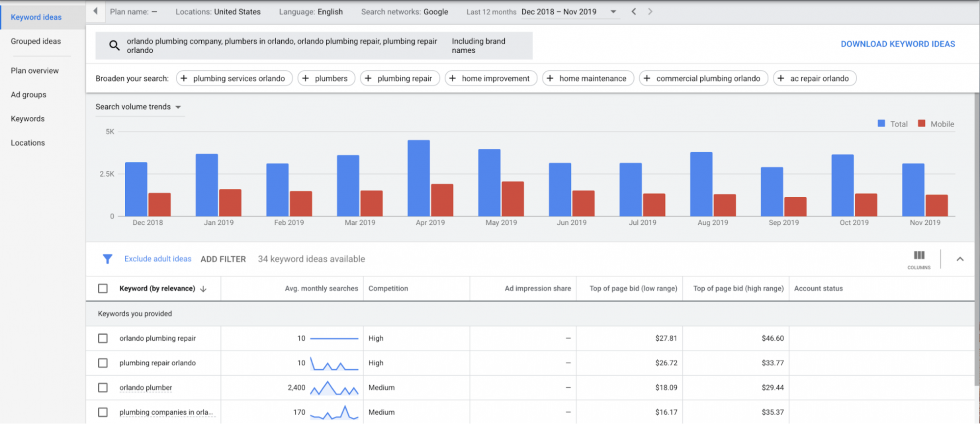
When you open the list, it’s important to find what the top keywords are. In our list the top two keywords that aren’t branded are
- Cheap plumber Orlando
- Best plumbers Orlando
These two keywords would both point towards a plumbing company. The difference is the intent behind the search. One person is looking for a cheap plumber, which shows intent to hire. The word ‘cheap’ shows urgency. They need a plumber right now and they’re worried about being unable to afford it. The other person is looking for the best plumbers in Orlando, which shows intent to discover. They’re probably not in urgent need of one if they’re willing to sit down and compare a few. They’re probably not even looking for your site. They probably want a blog post that ranks Orlando plumbers for them. This is why it’s so important to understand intent when trying to rank for certain words. If you rank for ‘best plumbers Orlando’ the visitors probably won’t turn into leads. If you rank for ‘cheap plumbers Orlando’ you’ll have a better turn out.
How to Beat Your Competitors
If you’re a small business, chances are you have to compete against big plumbing companies in your area, or even franchised companies like Roto Rooter. You’ll always have someone you need to beat, whether it’s in leads, sales, jobs, and yes, SEO ranking. It’s become clear how important SEO is in the world of internet marketing and companies are rushing to hire SEO specialists or outsource to companies like mine. One thing about SEO that I really like to take advantage of is using your competition’s advantages against them. There are two free Google Chrome Plugins that I use to help gain valuable information about your competitors.


Studying the Competitions
We’ll start with Mozbar. You need to install the plugin if you want to follow along. Just click the link in the photo. Let’s make a search for my main keyword: “orlando plumber”. When the results show up, you’ll need to scroll down past PPC ads. On the organic searches, Mozbar dropped stats about each site.
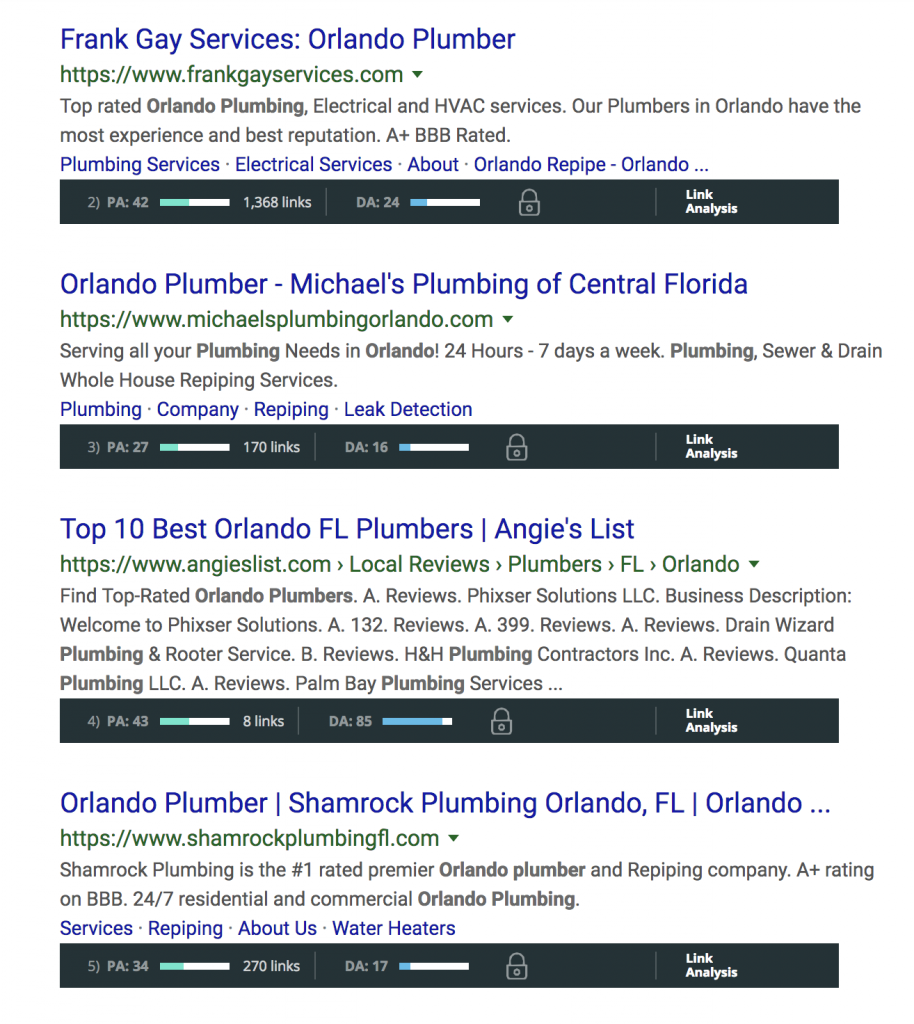
And there’s my competition. If I’m a small Orlando-based plumber, those are the companies I’m fighting. Now how does looking up my competition help me? Well, the Mozbar plugin shows me two statistics that are important.
Page Authority (PA) – How many websites are linking to the page. Domain Authority (DA) – How many websites are linking to the root domain. The higher these two numbers are, the harder it is to outrank. They may seem like small numbers, but Frank Gay has a PA of 42 and a DA of 24. If you look at Angie’s List, their PA is 43 and their DA is 85. They’re a HUGE reputable site and Frank Guy nearly matches their PA. This is a touch competitor.
Stats
You’ll need to watch out for: Trust Flow (TF) – Quality of backlinks pointing at that domain. Citation Flow (CF) – Power of backlinks pointing at that domain. Anchor Text Ratio – Ratio of link anchor texts pointing at that domain. Backlink profile – Majestic will display the indexed backlinks of any site you analyze. Let’s check out Frank Gay services and see what we can find. Click on the Majestic browser extension at the top of your browser. The symbol is a red star. This is what you’ll see.
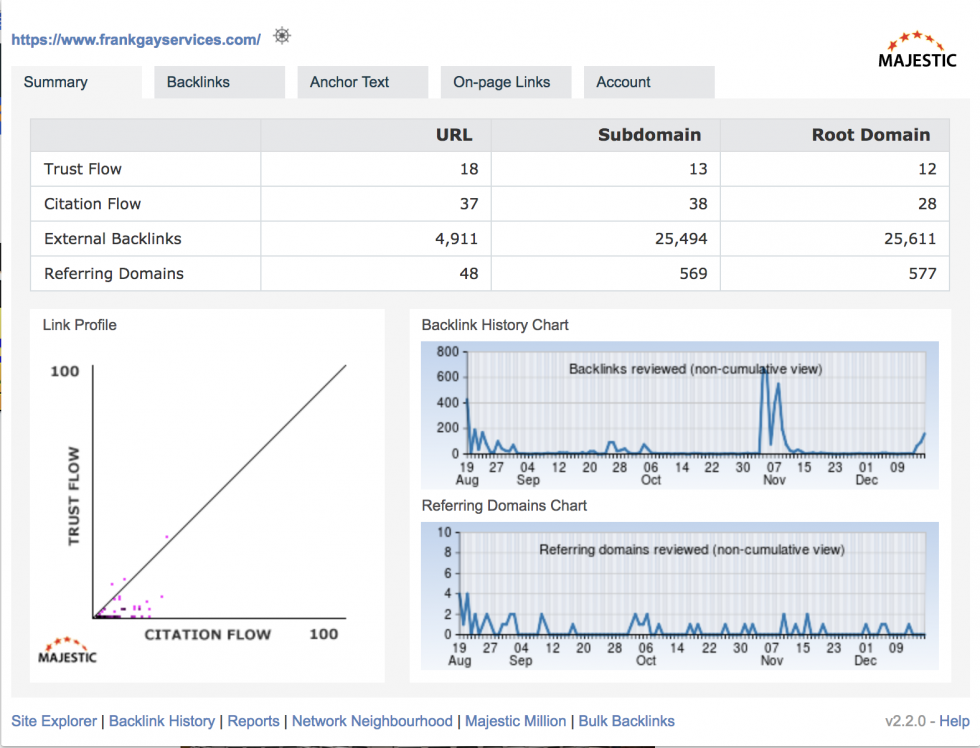
These are the results for Frank Gay (I got these stats from the URL, not the root domain)
TF – 18 CF – 37 Backlinks – 4,911 Referring Domains – 48 These numbers may seem small but I analyze site stats all the time and this guy’s SEO strategy is definitely why he’s ranking above anyone else for that search.
Anchor Charts
Now here’s another stat that’s important to point out. Anchor Text. Click the link at the top of the popup and scroll down until you see a donut chart.
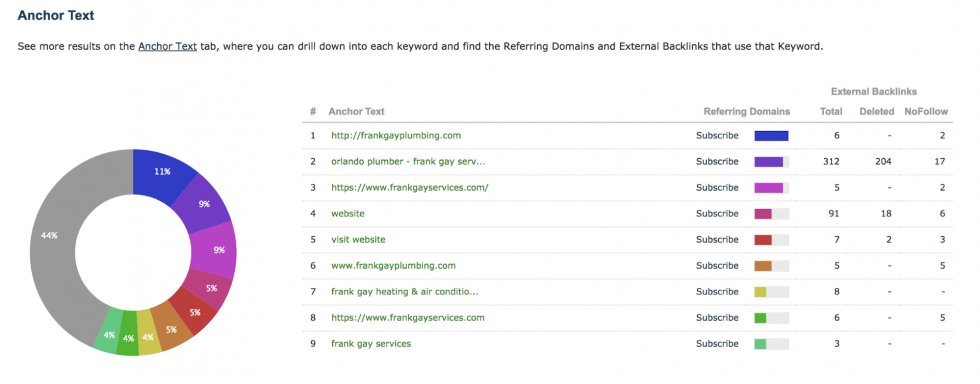
You’re probably wondering what anchor text it. Well, I have some all over this blog post. Anchor text is the word (or words) you use to leave a hyperlink. It can be the bareback www.swigglemedia.com, or the brand name with the link anchored into it, Swiggle Media. Back when SEO was easy, the links alone would suffice. Now, Google pays attention to the anchor text as well. Dumping links into your site or another site will actually get you penalized because it’s considered spam. If you want your links to be placed and anchored strategically, your anchor profile should look like this.
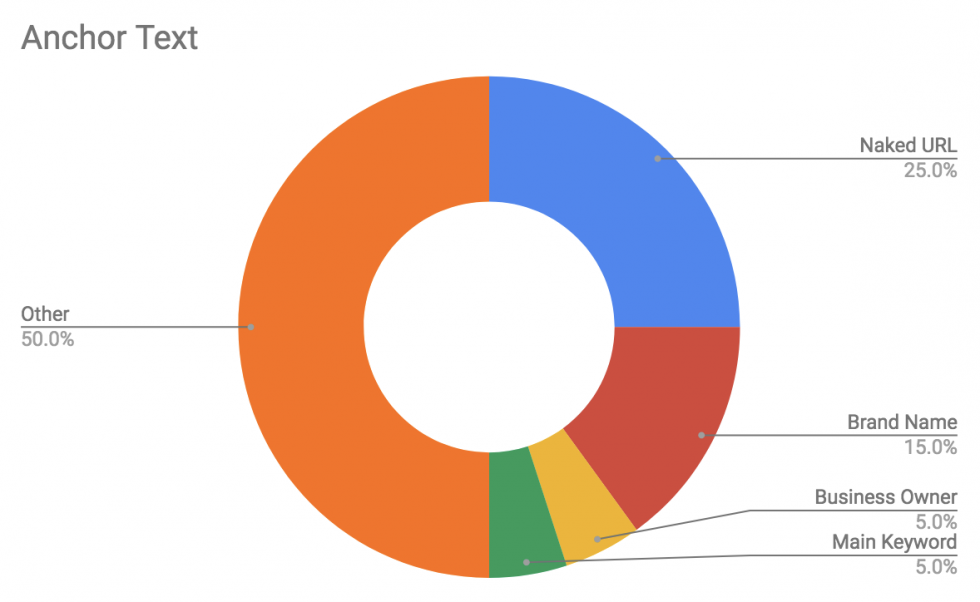
An anchor profile will never look this perfect, so I always analyze how it looks on a more general level. Do they hit all the anchor points? Do they anchor to their main keywords? How well is their naked url anchored? When we take a look at Frank Gay’s donut chart and compare it to what anchor text is being used, I can conclude that his anchor profile is helping him rank. Now how does this help you beat your competition? When I look at a piece of data like this, the first thing I think is: “I need to work on my site’s anchor text to bring it as close as possible to the ideal anchor profile, or at the very least to how the competition’s donut chart is oriented.”
Backlinks
I personally prefer to use a different site called SEMrush for analyzing backlinks but Majestic does the same thing. Go to the backlinks tab and you’ll be able to see the top sites that Frank Gay Services exists in. The best thing to do is start looking at the stats for each of those links and write them down, marking potential sites to backlink your own site to. Here’s the kicker. For my results, there are 14,519 backlinks. That’s a lot of backlinks to analyze. On top of that, you need to do the whole process again with the other sites that came up when you searched your main keyword. It’s tedious, it’s frustrating, and it’s time-consuming. Frank Gay has people to do this for him, whether he outsources or hires internally. He definitely doesn’t do it on his own; so why should you? This is why so many companies decide to outsource this type of thing. Unfortunately, you can’t just find a magical formula that will get you ranking number one in a day. It takes months to achieve top ranking for a keyword. I do everything in my power to get you to rank for multiple keywords.
How to Improve Your Site Structure
Google figures out the quality of a website by crawling through it. There are user experience elements that Google can see that we can’t. Often times, a website will be set up through a template found on the internet and the web designer won’t have a full understanding of the navigation, ease of access, or other UX elements that they should. All these factors determine the rank of your site. If a site isn’t optimized for SEO to begin with, it’s going to be difficult to restructure it. Swiggle Media has web design services that work hand in hand with our SEO expertise so all the sites we create are optimized for SEO. Plumbers are multi-talented, but there are times when they’re just plumbers and they only deal in plumbing services. Different types of companies need different site structures. Another element that structures a website are the locations that a company serves.
Single Service Companies
My mock company only focuses on plumbing, so I need to structure my website as a single service company. Single service sites would typically use an exact match domain (EMD) for their website URL (i.e. www.orlandoplumbing.com). Why? Because it hits all the important parts of the company. Where it’s based, and what they do. This is the only time an EMD should be used because it lessens a company’s chances to rank for other keywords. For single service companies, however, this will rank you for local searches. My mock company only does plumbing but as you know, there are different types of plumbing. That’s where service pages come in. These don’t outline different services, they outline different elements of plumbing. (i.e. www.orlandoplumbing.com/services/cloggeddrains etc). This makes up for the fact that you limited your ranking ability by using an EMD.
Multiple Service Companies
Let’s say my mock company actually does ac services, duct cleaning, bathroom remodeling, and electrical on top of plumbing. We’ll need a completely different site altogether for a company with multiple services. For a multi-service website, we wouldn’t use an EMD. If we did, you’d have contradicting services in a single URL (i.e www.orlandoplumbing.com/services/ac). Plumbing and AC are two different industries in the same link. This may not mean much to your site visitors but it confuses Google and ruins your chances of ranking. Your URL should include the brand of your company rather than the service. (i.e www.swiggleservices.com) When you start working on your service pages, your URLs should have the name of the service at the end (i.e www.swiggleservices.com/services/ductcleaning)
Companies with Multiple Locations
A Lot of plumbing companies cover many areas within a state as they are willing to travel. Some have offices in multiple states. Whichever coverage your company has, it’s good for Google to know where you service. If your company’s name is Orlando Plumbing but you don’t have separate site pages for servicing neighboring cities such as Jacksonville, your site won’t rank for any searches for plumbers in Jacksonville. One way you can express to Google that you service multiple locations is to add subsections to your website that are structured by those locations. This should be clear in your URL (i.e www.swiggleservices.com/orlando/services/; www.swiggleservices.com/jacksonville/services/).
Why is this so important?
You’ve probably noticed that every time you search for services you see two things before you even reach the organic searches; Ads and Local Searches. If a visitor is a potential lead, they’ll probably go for plumbers who definitely service their area. Local searches are where they find them. If your site is composed for multiple locations and those location keywords are in your URL, you’re more likely to rank for local searches.
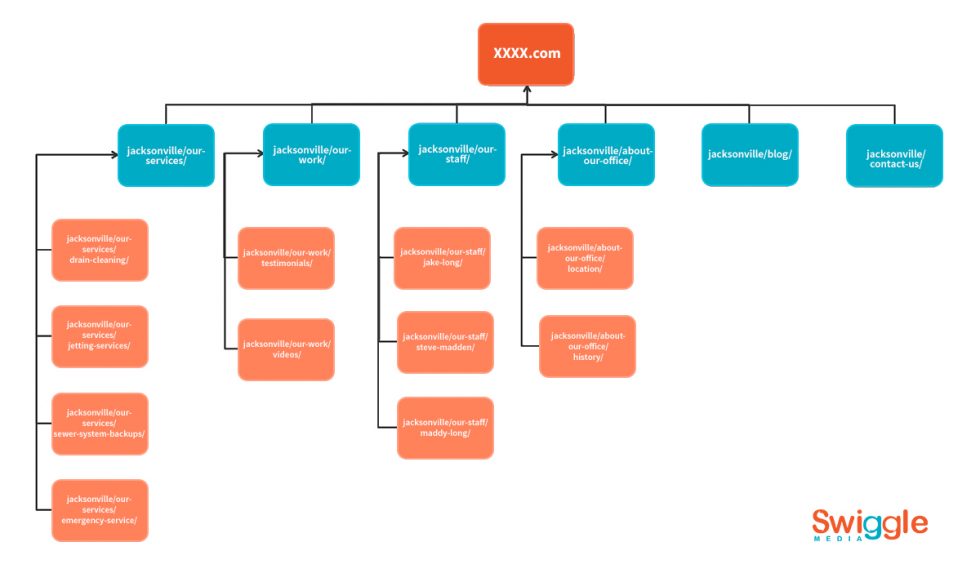
How to Appear in Local Searches
Speaking of local searches, there are other ways you can push your site to the top.
Google My Business
If you want to rank for local searches, the best way is to take advantage of a site with very high authority, Google’s own profile site. Google My Business profiles show up directly on localized results, as seen below. It’s important to be detailed, accurate, and targeted when creating a GMB page.
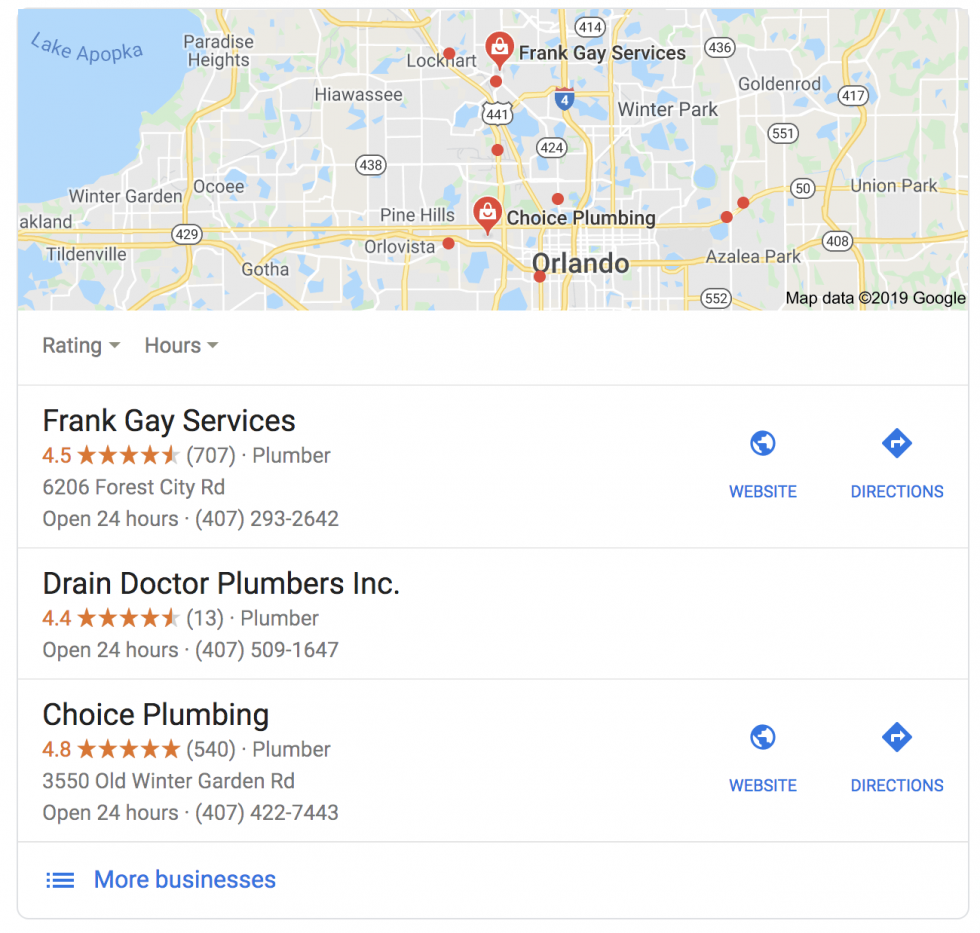
Signing up for GMB
You can sign up for a GMB page here. Best part is that it’s super easy and takes just a few minutes. If you already have a GMB profile, search for it and I’ll explain how you can snazzy it up in a moment. If you don’t have a GMB profile yet, look below the photo on the screen where it says “add your business to Google”. Start filling in all the details about your company:
- Company name
- Business category (plumber)
- Location of your office
- Locations where you serve (this is cool cause you can add multiple locations and rank for all those added)
- Phone number
- Link to your site.
Important– Before you can even start showing up for localized results, you need to verify your location. This can take up to 5 days because the code is mailed to your office. Once you verify your business, you’ll need to add more details to help visitors accurately choose your services. In the “Complete your listing” box, you’ll see that there are items you’ll need to add like the hours your office is open (or the hours you’re taking calls) a description of your services, and a logo. Need a logo done? Want custom graphics for all your company’s needs? Swiggle does that too.
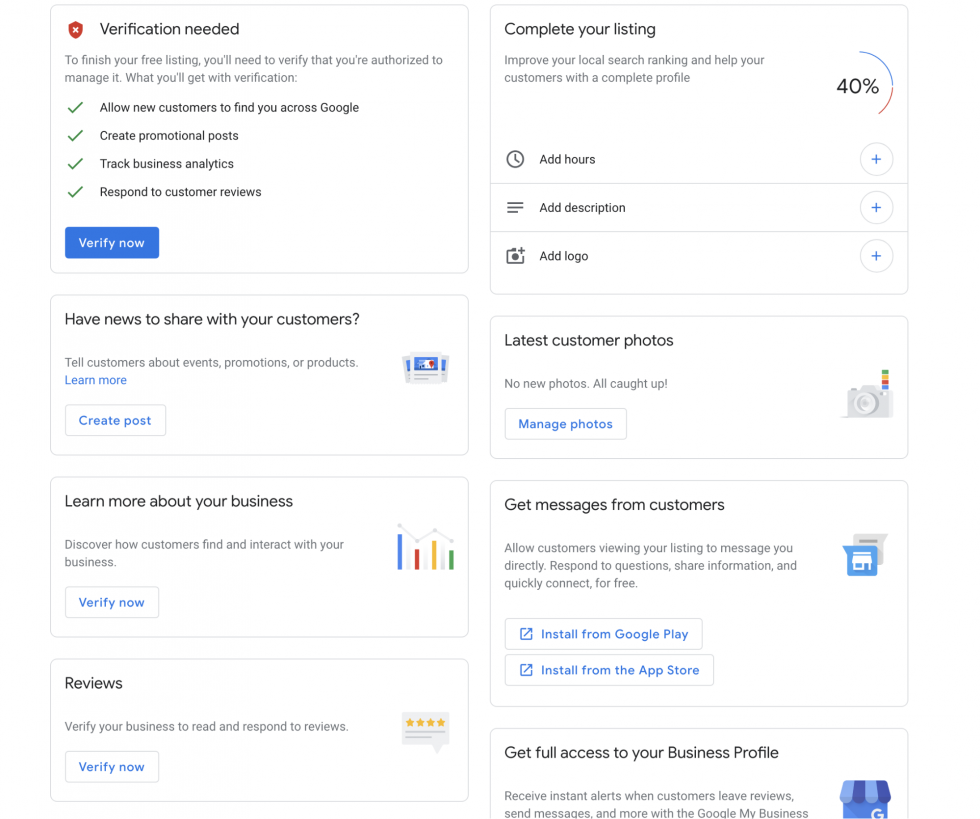
Now that you have all that filled in, I’ll show you what you need to change to have your GMB page SEO integrated. Follow these steps and your page will be much more attractive to both visitors and Google.
Change your business name
Change it to feature your main keyword first, then your the name of your business. For example: Orlando Plumbers – Swiggle Services This will give you a major ranking boost while also making the title more attractive to being clicked.
Don’t leave your description blank
A lot of companies leave their description blank because they think it’s pointless since all the information visitors will need is on their site. This can’t be farther from the truth. When they click on the localized search, they feel like they’re going into another site. They expect to see a description. The best descriptions are short yet informative. Your description shouldn’t be more than 200 words or less than 150.
Bonus tip: Use the description to map out your services and anchor links onto each one! This counts as link building!
Reviews
You can have hundreds of five star reviews of your services, but if they’re stuck on your website or social media, it won’t help you rank. In order for reviews to help your SEO, they need to be in local citations and directories.
Directories and Local Citations
Remember what you did on GMB? Now that it’s up, people can leave reviews for the world to see. But why stop at only one place? It’s important to use authoritative sites like Yelp, Angie’s List, BBB, and FourSquare. Sites like these take your online presence and match it with your physical business.
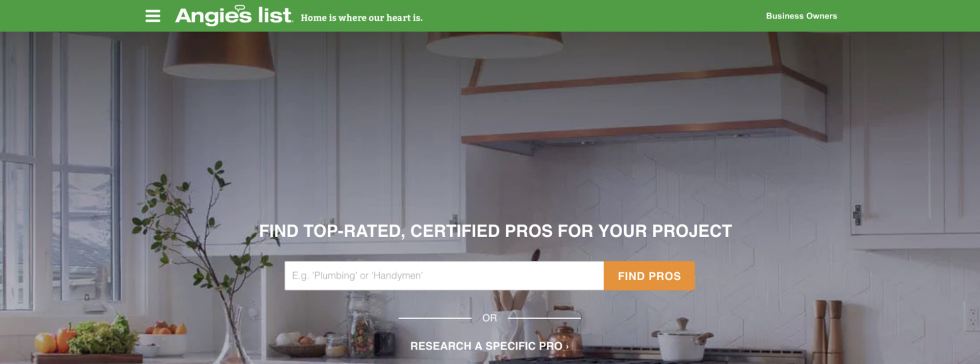
Having a presence on these sites reaches customers that don’t even use Google. It’s especially important for people in service industries because so many people will do research before investing their time and money into huge projects or emergency repairs. If you want to reach as many potential users as possible, you’ll need to manually create profiles for each of these sites and manage them consistently. That being said, it’s going to take you awhile. Outsourcing is the easiest way to get these types of tedious tasks done and it’s actually a service that Swiggle Media offers.
How to Create Good Content
If you’ve ever done research about SEO, there’s a lot of emphasis on content. It’s hard to think that after everything we’ve already done, our sites aren’t even close to being down when it comes to SEO integration. Like they say, “content is king”. Without great content on your site, it has no worth besides being a big expensive ad. At least, that’s what Google believes. Here’s the problem, so many companies will throw together content that promotes themselves and their services that all say the same thing. Everyone thinks they’re the best plumber out there, but how can your potential leads actually know that? Before I answer that question, we need to backtrack a bit.
Purchase Intent Keywords
Purchase intent keywords are sales focused. Typically these words would be directed at your services pages and are there for the sole purpose of letting Google know that that page is where you house information about the services you sell. You need to keep a focus on your main keyword in order to put all your efforts into ranking properly. Your main keyword needs to go into these places:
- The URL
- Title of the page
- h1 tag
- 1 image title
- 1 image alt tag
- 2 – 3 times in the page content
If you’re wondering how many words should be in a service page for it to be optimized for SEO, the answer is 350 words of relevant quality content.
Info Intent Keywords
Continuing past just purchase intent is something not many SEO companies will do. They’ll see that they’ve optimized the content that points to the most important elements of a company and leave it at that. However, the goal isn’t just to obtain leads, it’s to bring in organic traffic and get organic shares that will reach out to those who become leads. Google knows that the people who use their search engine aren’t only there to find services to purchase. They are also looking for information. In fact, 80% of searches are informational and only 20% are navigational or transactional. You want your site to appeal to that 80%. It doesn’t stop there. Your content not only has to be informational, it has to be of quality. Now you could write the best article about the benefits of a tankless water heater but if no one shares it or links back to it, Google thinks it’s worthless. That’s why it’s so important to write informational content. No one is going to share your service webpage because it’s not content people want to read unless they’re actively looking for it. But if someone is thinking about getting a tankless water heater and reads your article about it, suddenly they’ll want to share what convinced them to make the investments.
Searchable Keywords
Your Info intent keywords are ones that your users would search for if they wanted information about plumbing. Keywords like , and are probably popular ones. You need to rebuild your content around keywords like these. If you get asked a question a lot, maybe consider writing a blog about it. There are multiple different types of blog posts you can create, but there are three main areas that you should focus on. Why? Cause they are commonly searched and highly shareable. How to guides – “How to unclog a drain” Information – “The importance of a full home plumbing inspection” Infographics – “5 benefits of preventative maintenance”
How to link build
I mentioned this before but now’s the time to go deeper into link building. I talked about taking your competitor’s links and neutralizing them, but you still need to build your own links to get ahead of the game. Link building is actually the #1 ranking factor in SEO. That’s why during site analysis, high ranking sites will have thousands of backlinks driving traffic to their site. Here’s why links are important. Bots crawl through your website to see what it’s all about, but they can only really analyze important keywords and structure. They can’t tell if your content or site is of quality the way that we do. The way they do it is by counting how many high quality links are leading to your site. This tells them “over 2,000 people have looked at this blog and shared it on their own site. That means it must be good”. A single link can take a long time to obtain and it can be time-consuming to gather as many as you’ll need to rank. If you look below, you’ll see that Frank Gay Services has 14,500+ links. This probably took a few years to achieve and eventually, backlinks start to occur naturally without any effort besides creating the content. But to start, it’s a tedious process.
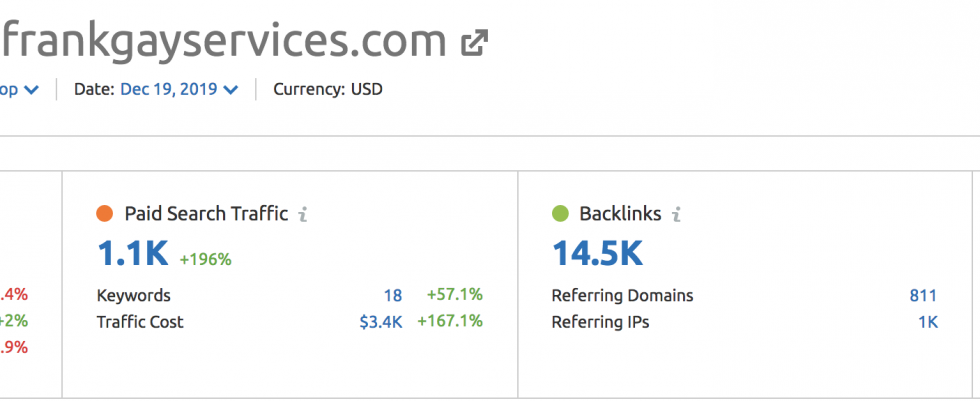
Social Media
The easiest form of natural link building through social media. Developing your company’s Facebook page allows for a direct link to your site content that can be distributed onto other FB pages and even across platforms. Having a Youtube page is another great way to have amazing content that can be linked back into your site’s blog and vice versa. If you make a video showing how to unclog a drain, you can post it on Youtube and then post a link of that video into your blogpost about Common Causes of a Clogged Drain. Someone who owns a blog about your industry might share your blog post along with the video because they don’t have a post about clogged drains yet. When they credit you, they will often link the page of the blog post. Add the imbedded video and that’s 3 links right there. Share your video to Facebook and that’s 4.
Quora
If you have a question and type it into Google, chances are Quora is one of the search results. Quora is a question and answer site that allows users to answer questions that other users post. There’s a wide variety of questions that can be asked on Quora and because there is no limit to the type of content you can find on there. There will definitely be questions about plumbing. Because of this, there are hundreds of potential questions you can answer with a link to your blog post. Why a link as an answer? Because blogs are informative. They may think they want a two sentence answer, but when you give them more, they take it. Let’s go back to the clogged drain example. Let’s say you wrote that article on “Common Causes of a Clogged Drain”, you can go on Quora and search the question “causes a clogged drain drain?”. Look through the results and find one where a link to your blog post would be beneficial. Make sure to write some content so it doesn’t look like you’re just leaving the link there for no reason. You can also anchor your link to a keyword like this person did:
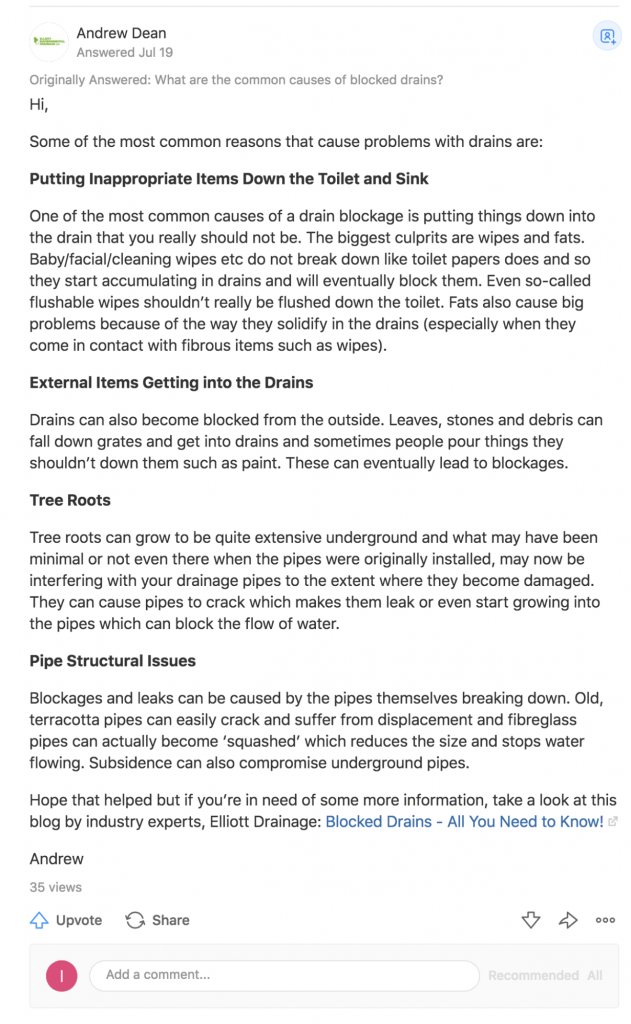
Do this for all of the blog posts you think could be someone’s answer. You can drop a link to the same blog post on multiple questions since Quora users sometimes ask questions that other users already have. As you can see, there are plenty of threads you can contribute to:

White Hat Link Building in Resource Pages
Many blogs have what are called resource pages filled with links to relevant sites within the blog’s niche. It’s really easy to find resource pages if you use Google’s search operators:
- Plumbing inurl:resources
- Plumbing Blog inurl:resources
- Plumbers:resources
- Plumber’s Blog intitle:resources
- Plumber’s blog “resource pages”
- Contractor’s blog “resource pages”
The results would look something like this:
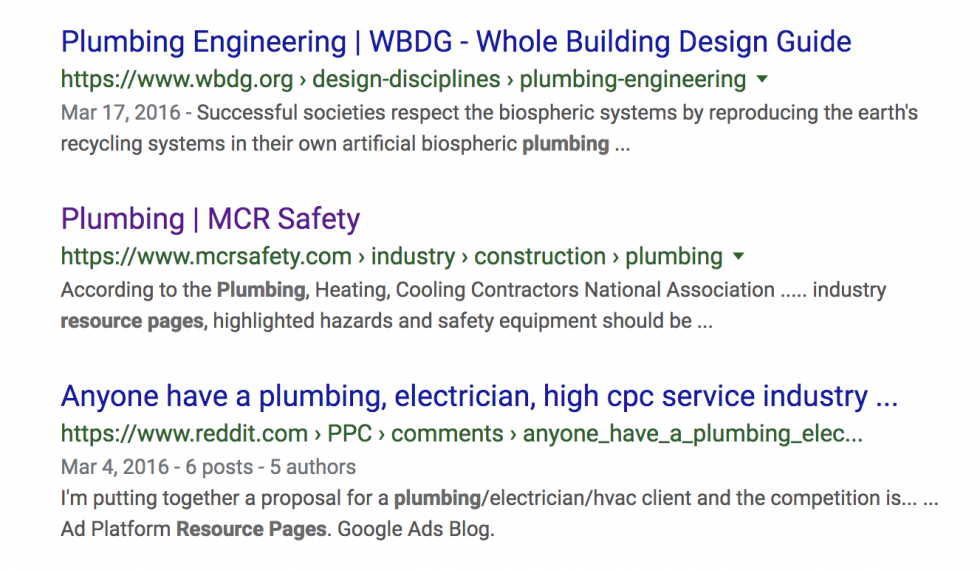
The result in purple was the one I found to contain a resource page. When you click on it, this is what you see:
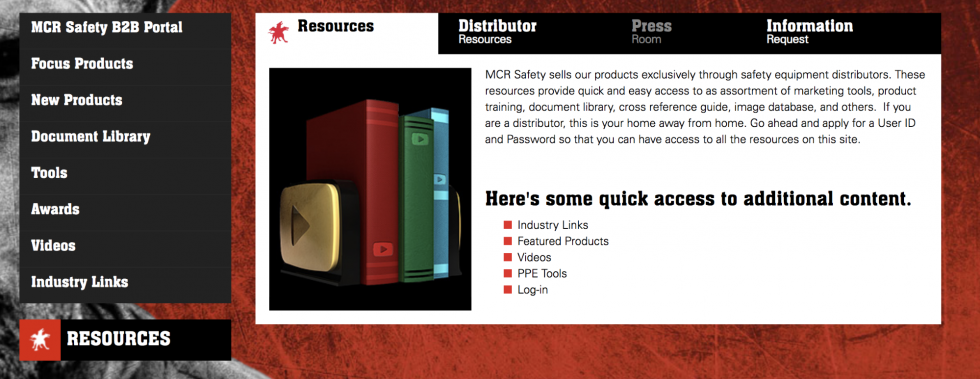
You can email the people there to see if you can have your link placed into their resource page.
“Borrowing” Links
Earlier on we looked at the backlinks of the competition and saw what authoritative sites they were linking to. I like to “borrow” those and see if we can get the same sites to link to us to. I put it in quotes because it’s more along the lines of stealing the links. But it’s okay. If they had a really great SEO expert on their side, they’d probably do the same thing.
Guest Posting
Guest blogging is something that SEO companies tend to overlook. They don’t want your content to appear on other people’s site and lose control of properly anchoring text and other important linking elements. I, on the other hand, think that guest blogging is a great opportunity to get some high quality links. When you write in a guest blog, they usually let you drop a link to your blog site or anchor text within your blog to other pages on your site.
- plumbing “accepting guest posts”
- plumbing “write for us”
- plumbing “guest post courtesy of”
- plumbing “guest bloggers wanted”
- plumbing “guest post opportunities”
- plumbing “become a guest writer”
How can I track my ROI?
After all is said and done and your site is finally SEO integrated, it’s time to start tracking how your efforts are improving your site. Not only can you see your site improve, but your business as well. Tracking ROI (return on investment) lets you see whether or not there has been an increase in site clicks, leads, new jobs, and more. You do this by studying the analytics. Analytics helps figure out what’s working and what’s not. I use:  We’re going to be looking at 3 reports that these two offer that will help us gain an understanding of the ROI from our SEO efforts.
We’re going to be looking at 3 reports that these two offer that will help us gain an understanding of the ROI from our SEO efforts.
Analyzing Organic Traffic
I’ve probably mentioned organic traffic a lot without actually explaining what it is. Organic traffic is the traffic brought to your site because of unpaid searches. So if someone searched “how to unclog my drain” and clicked on your blog post that wasn’t pushed into the SERPs by a paid ad, that’s an organic visit. Here’s a visual guide to setting up Organic Filters in Analytics Go to Audience > Mobile > Overview on the side bar. Click All Users and set the filter to organic traffic
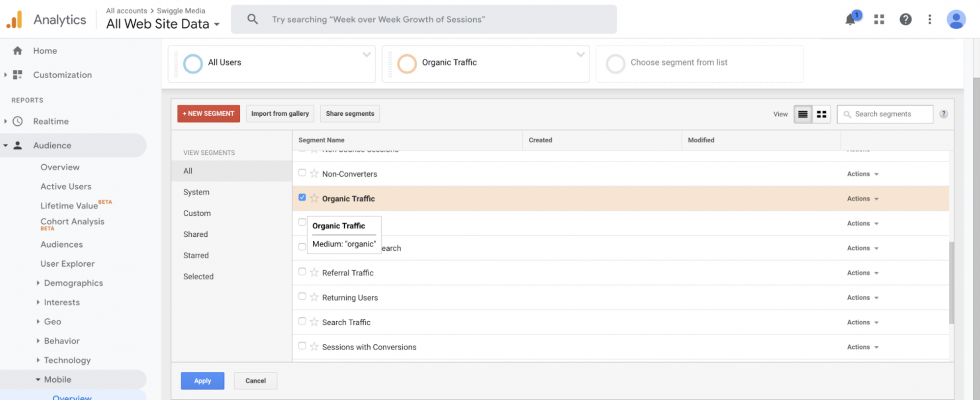
Remove “All Sessions” so you can see the content clearly
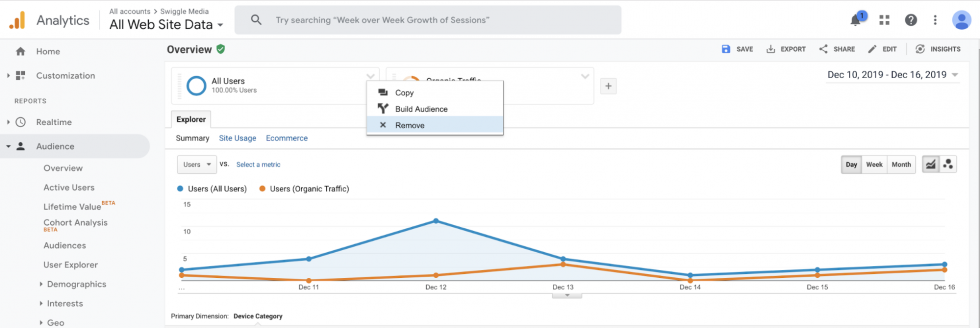
Set dates to when you want to analyze the traffic. If you’re just not setting up Google Analytics, you may not be able to go back in time.

There you have it, organic traffic for your site! You need to keep an eye on this as time goes by to see if your SEO is bringing in organic traffic.
Finding the Value behind SEO
There are things that need to be set up in SEO that allow for an analysis of your site to happen in the first place. One thing that’s vital to analysis tracking is Goals. What are Goals you might ask? In the SEO sense, Goals track when a user submits a form on your site. I wrote out exactly how to create Goals in Google Analytics for this purpose.
- Start on the Admin tab
- Go to Goals under View
- Click New Goal
- Where it says Goal Setup, create an account
- Proceed to Next Step
- You have free reign here. Pick a name for your goal based on what the form is. If it’s a Newsletter form enter “Newsletter Form”
- Find where it says Type and select Destination
- Proceed to Next Step
- Find Destination and select Equals to
- In the type bar, type in the exact URL to the page that appears after a form is submitted NOTE: If forms don’t redirect to a thank you page after submission, you’ll need to set up a custom event before turning it into a goal.
- Click Verify goal – If all goes well, you’ll see a conversion %
- Click Create Goal
To find the report with information about SEO’s value, go to Behavior > Site Content > Landing Pages on the sidebar Keep the organic traffic segment open. This report shows which pages are receiving the most organic traffic, associated engagements and goal completions. It’s important to keep track of because each page on your site needs to have a certain set of keywords integrated into it. The conversion rates that you find here tell you which keywords are of value.
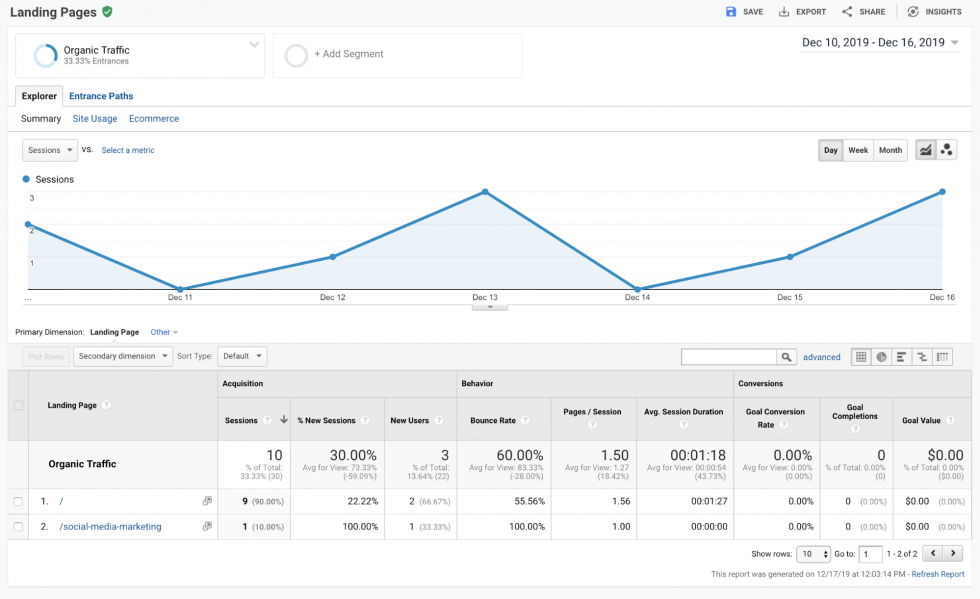
Here’s where things get fun. You worked all this time, did all these crazy things to your site, and now it’s time to see if your investment was worth it. Here’s the information you’ll need:
- Monthly Cost= $X,XXX
- Monthly organic Traffic =
- Organic Leads =
- Organic Conversion Rate =
Input the data into an Excel spreadsheet. Then, add the amount of leads converted to customers and the total revenue gained from it. To find your Net Profit just subtract Total Revenue Gained – Total SEO Costs = SEO Net Profit. Now you have how much money SEO has made for you! That’s always great to look at but the best thing about analytics is that we can find out the true conversion rate of your site and calculate the potential of SEO! Take the Total Revenue divided by Clients Gained = Average Revenue per client Now you need to get the percentages from the chart above to multiple the Analytics Conversion Rate * Lead Conversion to Client Rate = True Conversion Rate By changing the amount of traffic in the equation, you can estimate and gauge the impact on your revenue. The more you put in, the more you get out. To find out how much revenue SEO can really bring, just change the amount of traffic. This will open your eyes to how much money SEO can make for you when done properly. Closing Now I know you’re probably overwhelmed. Who wouldn’t be? SEO is a lot of work. Do you feel like you could do SEO for your plumbing company? It’s definitely possible. There are so many resources out there that DIY SEO isn’t an impossible task. The question is, do you want to be the one to plan, implement, and manage it all? There are so many other things that you could be doing and I’m sure that SEO isn’t top priority on your to-do list. Truth be told, it’s not as easy as I make it out to be in this blog. There are so many elements that I didn’t go into detail with and that’s because it would take more than a single blog post to cover it all. SEO is one of the most powerful tools in internet marketing and it has long lasting effects that traditional marketing just doesn’t. And if you’re going to do it, you should do it right. I look forward to hearing from you.




